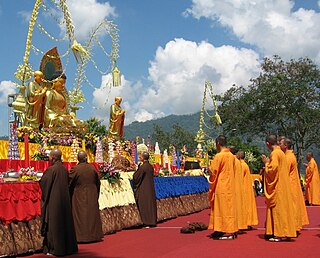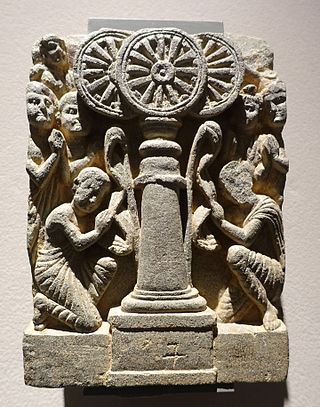Related Research Articles

The five precepts or five rules of training is the most important system of morality for Buddhist lay people. They constitute the basic code of ethics to be respected by lay followers of Buddhism. The precepts are commitments to abstain from killing living beings, stealing, sexual misconduct, lying and intoxication. Within the Buddhist doctrine, they are meant to develop mind and character to make progress on the path to enlightenment. They are sometimes referred to as the Śrāvakayāna precepts in the Mahāyāna tradition, contrasting them with the bodhisattva precepts. The five precepts form the basis of several parts of Buddhist doctrine, both lay and monastic. With regard to their fundamental role in Buddhist ethics, they have been compared with the ten commandments in Abrahamic religions or the ethical codes of Confucianism. The precepts have been connected with utilitarianist, deontological and virtue approaches to ethics, though by 2017, such categorization by western terminology had mostly been abandoned by scholars. The precepts have been compared with human rights because of their universal nature, and some scholars argue they can complement the concept of human rights.

Sangha is a Sanskrit word used in many Indian languages, including Pali meaning "association", "assembly", "company" or "community"; Sangha is often used as a surname across these languages. It was historically used in a political context to denote a governing assembly in a republic or a kingdom, and has long been used by religious associations including the Buddhists, Jains and Sikhs. Given this history, some Buddhists have said the tradition of the sangha represents humanity's oldest surviving democratic institution.
Theravāda is the most commonly accepted name of Buddhism's oldest existing school. The school's adherents, termed Theravādins, have preserved their version of Gautama Buddha's teaching or Buddha Dhamma in the Pāli Canon for over two millennia.

Vesak, also known as Buddha Jayanti, Buddha Purnima and Buddha Day, is a holiday traditionally observed by Buddhists in South Asia and Southeast Asia as well as Tibet and Mongolia. It is the most important Buddhist festival. The festival commemorates the birth, enlightenment (Nibbāna), and death (Parinirvāna) of Gautama Buddha in Theravada, Tibetan Buddhism and Navayana.

In Buddhism, refuge or taking refuge refers to a religious practice, which often includes a prayer or recitation performed at the beginning of the day or of a practice session. Since the period of Early Buddhism all Theravada and mainstream Mahayana schools only take refuge in the Three Jewels which are the Buddha, the Dharma and the Sangha.

Upāsaka (masculine) or Upāsikā (feminine) are from the Sanskrit and Pāli words for "attendant". This is the title of followers of Buddhism who are not monks, nuns, or novice monastics in a Buddhist order, and who undertake certain vows. In modern times they have a connotation of dedicated piety that is best suggested by terms such as "lay devotee" or "devout lay follower".

Buddhism, specifically Theravāda Buddhism, is the State religion of Myanmar since 1961, and practiced by nearly 90% of the population. It is the most religious Buddhist country in terms of the proportion of monks in the population and proportion of income spent on religion. Adherents are most likely found among the dominant Bamar people, Shan, Rakhine, Mon, Karen, and Chinese who are well integrated into Burmese society. Monks, collectively known as the sangha (community), are venerated members of Burmese society. Among many ethnic groups in Myanmar, including the Bamar and Shan, Theravada Buddhism is practiced in conjunction with the worship of nats, which are spirits who can intercede in worldly affairs.

Buddhism, also known as Buddha Dharma and Dharmavinaya, is an Indian religion or philosophical tradition based on teachings attributed to the Buddha. It originated in present-day North India as a śramaṇa–movement in the 5th century BCE, and gradually spread throughout much of Asia via the Silk Road. It is the world's fourth-largest religion, with over 520 million followers (Buddhists) who comprise seven percent of the global population.

Buddhist ethics are traditionally based on what Buddhists view as the enlightened perspective of the Buddha. The term for ethics or morality used in Buddhism is Śīla or sīla (Pāli). Śīla in Buddhism is one of three sections of the Noble Eightfold Path, and is a code of conduct that embraces a commitment to harmony and self-restraint with the principal motivation being nonviolence, or freedom from causing harm. It has been variously described as virtue, moral discipline and precept.
In Buddhism, the eight precepts is a list of precepts that are observed by lay Buddhists on observance days and festivals. They include general precepts such as refraining from killing, but also more specific ones, such as abstaining from cosmetics and entertainments. This tradition of keeping the eight precepts on observance days are still widely practice in all Theravadin Buddhist countries and Theravadin Buddhist communities worldwide. Based on pre-Buddhist sāmaṇa practices, the eight precepts are often upheld on the Buddhist observance days, and in such context called the uposatha vows or one-day precepts. They are considered to support meditation practice, and are often observed when staying in monasteries and temples. In some periods and places the precepts were widely observed, such as in 7th–10th-century China by government officials. In modern times, there have been revival movements and important political figures that have observed them continuously.
In English translations of Buddhist texts, householder denotes a variety of terms. Most broadly, it refers to any layperson, and most narrowly, to a wealthy and prestigious familial patriarch. In contemporary Buddhist communities, householder is often used synonymously with laity, or non-monastics.
A prostration is a gesture used in Buddhist practice to show reverence to the Triple Gem and other objects of veneration.
The Uposatha is a Buddhist day of observance, in existence from the Buddha's time, and still being kept today by Buddhist practitioners. The Buddha taught that the Uposatha day is for "the cleansing of the defiled mind," resulting in inner calm and joy. On this day, both lay and ordained members of the sangha intensify their practice, deepen their knowledge and express communal commitment through millennia-old acts of lay-monastic reciprocity. On these days, the lay followers make a conscious effort to keep the Five Precepts or the ten precepts. It is a day for practicing the Buddha's teachings and meditation.
Devotion, a central practice in Buddhism, refers to commitment to religious observances or to an object or person, and may be translated with Sanskrit or Pāli terms like saddhā, gārava or pūjā. Central to Buddhist devotion is the practice of Buddhānussati, the recollection of the inspiring qualities of the Buddha. Although buddhānussati was an important aspect of practice since Buddhism's early period, its importance was amplified with the arising of Mahāyāna Buddhism. Specifically, with Pure Land Buddhism, many forms of devotion were developed to recollect and connect with the celestial Buddhas, especially Amitābha.

A kyaung is a monastery (vihara), comprising the domestic quarters and workplaces of Buddhist monks. Burmese kyaungs are sometimes also occupied by novice monks (samanera), lay attendants (kappiya), nuns (thilashin), and young acolytes observing the five precepts.

The ten principal disciples were the main disciples of Gautama Buddha. Depending on the scripture, the disciples included in this group vary. In many Mahāyāna discourses, these ten disciples are mentioned, but in differing order. The ten disciples can be found as an iconographic group in notable places in the Mogao Caves. They are mentioned in Chinese texts from the fourth century BCE until the twelfth century CE, and are the most honored of the groups of disciples, especially so in China and Central Asia. The ten disciples are mentioned in the Mahāyāna text Vimalakīrti-nideśa, among others. In this text, they are called the "Ten Wise Ones", a term which is normally used for the disciples of Confucius.
In the Buddha's first discourse, he identifies craving (tanha) as the cause of suffering (dukkha). He then identifies three objects of craving: the craving for existence; the craving for non-existence and the craving for sense pleasures (kama). Kama is identified as one of five hindrances to the attainment of jhana according to the Buddha's teaching. Throughout the Sutta Pitaka the Buddha often compares sexual pleasure to arrows or darts. So in the Kama Sutta (4.1) from the Sutta Nipata the Buddha explains that craving sexual pleasure is a cause of suffering.
If one, longing for sensual pleasure, achieves it, yes, he's enraptured at heart. The mortal gets what he wants. But if for that person — longing, desiring — the pleasures diminish, he's shattered, as if shot with an arrow.

The Pāli Canon is the standard collection of scriptures in the Theravada Buddhist tradition, as preserved in the Pāli language. It is the most complete extant early Buddhist canon. It derives mainly from the Tamrashatiya school.

Shin Upagutta is an arahant commonly venerated by Buddhists in Myanmar. He is believed to protect worshipers from danger, including floods and storms. He is also venerated in Northern Thailand and Laos, where he is known as Upakhut.
Gadaw is a Burmese verb referring to a Burmese tradition in which a person, always of lower social standing, pays respect or homage to a person of higher standing, by kneeling before them and paying obeisance with joined hands, and bowing. This is usually done by students to their teachers or children or grandchildren to their elders, in order to show gratitude and reverence and an opportunity to ask for forgiveness, often involving gift-giving.
References
- ↑ Nash, Manning (1963-04-01). "Burmese Buddhism in Everyday Life". American Anthropologist. 65 (2): 285–295. doi:10.1525/aa.1963.65.2.02a00050. ISSN 1548-1433.
- ↑ "Okasa, Okāsa: 3 definitions". Wisdom Library. 2014-08-15. Retrieved 2016-12-04.
- ↑ Than Htut, Henry. "Buddhist Homage and Affirmations". www.myanmarnet.net. Retrieved 2016-12-04.
- ↑ Rozenberg, Guillaume; Keeler, Ward (2011-06-09). "The Saint Who Did Not Want to Die: The Multiple Deaths of an Immortal Burmese Holy Man". Journal of Burma Studies . 15 (1): 69–118. doi:10.1353/jbs.2011.0000. ISSN 2010-314X.
- ↑ Spiro, Melford (1982). Buddhism and society: a great tradition and its Burmese vicissitudes. University of California Press. p. 210. ISBN 978-0-520-04672-6.